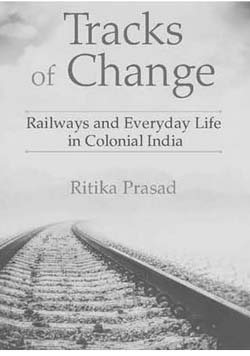The history of technology in India, and more specifically that of technological transfer from the metropole to colony, has been narrated from a number of perspectives, ranging from critical (technology as disruption) to laudatory (technology as redemption). In the context of the history of the railways in India, Ian Kerr with his Building the Railways of the Raj (1995) and Engines of Change (2007) has extensively mapped the processes by which the railways were planted, and thrived, in colonial India. Ritika Prasad, while drawing on his work and that of other scholars on the history of transportation technology and society in India (Laura Bear, Ravi Ahuja and Nitin Sinha, among others), narrates the story of the railways in India in a different way, adding several fascinating dimensions. Much like railway sleepers, with their two vertical rails crisscrossed by numerous horizontal ties, this book anchors itself to the fact of the coming of the railways to India in order to explore issues that go far beyond the technology itself. Gender, race, caste, medicine, crime, surveillance, popular resistance, pilgrimage, land acquisition, conceptions of time and space, anti-colonial nationalism—these are only a few of the several themes that are bound together in this book using the vertical rails of the railways.
Michel de Certeau’s concept of ‘Everyday Life’, as applied to the Indian context by David Arnold, Gyan Prakash and others provides the theoretical basis for Prasad’s book. She defines ‘everyday’ as ‘a space of continuous, daily, negotiation between people and the technology that permeates their lives’ (p. 10). This enables her to achieve her task as a historian by ‘highlighting how the historical meaning of new technology is materialized through everyday use’ (p. 281). By focusing not just on the importation of new technology but on its reception, Prasad is able to demonstrate ‘how popular processes of adapting to, contesting, and accommodating technological change determine the historical impact of such change’ (p. 282). The Indian public, therefore, takes centre stage in this story. In the contested terrain of South Asian historiography, this concept also allows for elite and subaltern preoccupations as well as actions to be studied in a single frame of reference.
The story of the railways in India, as told by Prasad, is a story of several paradoxes. One paradox involves Indians who, at different historical moments, protested against reserved compartments for Europeans and Anglo-Indians but demanded reserved compartments for Indians of different castes and religions from themselves. Another is that of the stance of anti-colonial nationalists who used trains to travel in order to implement their plans of sabotaging that most visible symbol of colonial rule—the train. Although intended to be a strategic technology that protected the British in India (by facilitating quick troop movement, for example) the railways and sabotage thereof also became a significant symbol of the erosion of that very rule. The same technology that facilitated movement for work, leisure, or pilgrimage also destroyed lives and livelihoods (when high railway embankments trapped floodwater, for instance).

